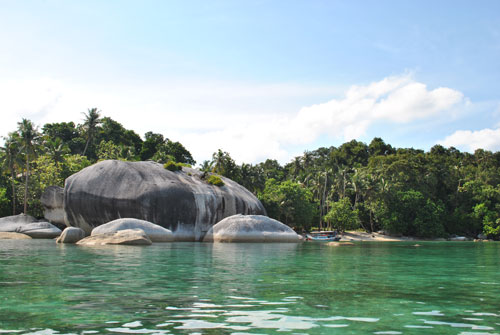A successful novel turned movie has provided the impetus for a small island to step out of its tin-mining past and discover the other treasures it has.

A hidden gem in the east coast of Sumatra, Belitung is striving to gain recognition as a tourist destination for regional and international travellers.
Part of the Bangka-Belitung Province, Belitung was home to a thriving tin mining industry in the 1970s, but the economy took a turn in the late 1990s when the state-owned Timah Industri moved its tin operations to the much bigger neighbouring island of Bangka.
It was not until Andrea Hirata’s novel Laskar Pelangi (English: The Rainbow Troops) – set in the author’s hometown in Belitung’s Gantong Village following the demise of the local tin mining industry – was adapted into a successful movie in 2008 that Belitung started attracting Indonesian and expatriate visitors and the locals had their eyes opened to the island’s tourism potential.
The destination came to be dubbed Bumi Laskar Pelangi (Land of the Rainbow Troops) and the Andrea Hirata Words Museum was built on the film site in Gantong Village in 2010.
Lending Belitung its tremendous potential for tourism are several sites that stand testament to the island’s unique history and natural biodiversity, according to Budi Setiawan, director of Belitung Adventure Tours and Tourism Destination Board.
Around Tanjung Kelayang in the north, natural granite formations can be found on land and in the ocean – sometimes hundreds of metres deep – while remnants of sunken ships that sailed from China, Arabia and Europe centuries ago lie in the southern islands of Belitung.
“The fact that these ships brought valuable goods such as porcelain of Tang, Ming, Song and other Chinese dynasties has made the area an historic underwater archaeological site,” said Budi.
Another highlight is the tarsier, an endangered species of small primates found in Belitung’s rainforests.
“The locals used to take (the tarsiers) for granted and chased them out of their gardens. Only when tourists started travelling from far away to see them did the locals get reminded of their value,” said Budi, who also heads the Belitung Environment Concern Group.
Budi posits that community-based tourism is the way forward for Belitung, but admits that adjusting to a service-oriented industry like tourism will take time for the locals.
Local engagement is thus key to ensuring the sustainable development of both tourism and livelihoods.
“The locals know the forest and mangrove areas best; they are divers by nature and they are proud of their homeland,” said Budi. “In the past, some of them were pirates; some bombed corals to sell. We trained them to become guides. The dive guides, for example, are certified now.”
As part of conservation projects, Budi runs educational tours for travellers, corporate groups and students. Activities available include island hopping, trekking, diving, river tubing, tarsier watching, coral planting and adoptions, turtle release and mangrove touring.
Meanwhile, there are plans to develop Leebong Island – a 37ha isle three kilometres off Belitung’s coast – with an eco-friendly approach. Yudianto, owner of Belitung Happy Tour, the sister company of Leebong Island management, said: “We will build a limited number of accommodation and recreational facilities. Currently, we are in the first phase of development and one out of five bungalows and the restaurant is ready.”
Also underway are plans by the Bangka Belitung government to expand the runway from 2,225m to 2,550m at the H.A.S. Hanandjoeddin Airport in Tanjung Pandan, the capital of Belitung.
Arief Yahya, Indonesian minister of tourism, commented: “Airport development is crucial if Belitung wants its tourism to grow.”
In September last year, Indonesian president Joko Widodo inaugurated Tanjung Batu Seaport. Tanjung Kelayang has been named one of the 10 special economic zones to be developed and promoted by the Indonesian Ministry of Tourism.
Apart from hotels, a port for yachts will be built at Tanjung Kelayang. The whole project is expected to finalise in five years.
This article was first published in TTG Asia, March 4, 2016 issue, on page 32. To read more, please view our digital edition or click here to subscribe.




















